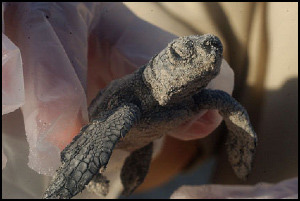 |
 |
 |
 Editorials | Environmental | July 2006 Editorials | Environmental | July 2006  
Endangered Turtles Returning
 Bill Hanna - Fort Worth Star-Telegram Bill Hanna - Fort Worth Star-Telegram


| | Historical records aren't clear, but Burchfield and others believe that Kemp's ridley turtles were once far more common on portions of the Texas coast. And if the numbers continue to climb in Mexico, he predicts that the habitat will expand to other parts of Texas. |
Tepehuajes, Mexico - This is the story of a remarkable comeback.

A rejuvenation that many experts considered all but impossible 20 years ago.

But on the remote beaches of northern Mexico, the most endangered of all sea turtles, the Kemp's ridley, is marching back from the brink of extinction.

Based in simple camps and basic corrals, teams of Mexican and American biologists and volunteers patrol miles of remote beaches for nests and then dig up the eggs to protect them from predators and poachers.

The week of June 25 marked the peak of hatching season as more than 200,000 hatchlings made their slow crawl to the sea.

As the sun set on June 28 at Tepehuajes, the freshly hatched sea turtles were taken out of protective crates and placed one by one on the sand. It only takes about 10 minutes for the quickest of the tiny turtles, which can easily fit in your palm, to trundle a few feet into the Gulf of Mexico.

Some take far longer, including one clutch of turtles that were returned to their crate after it was determined they weren't quite ready to meet the sea. A few hours later, they, too, disappeared into the gulf waves.

The releases set a new benchmark for the joint conservation effort between Mexico and the United States that began 26 years ago to save the smallest sea turtle species.

It was almost too late.

In 1985, when only 702 nests were found on Mexican beaches, many scientists predicted that the Kemp's ridley wouldn't be around for long.

"It looked pretty bleak," said Patrick Burchfield, the deputy director of Gladys Porter Zoo in Brownsville, Texas, who oversees the U.S. portion of the conservation project for the U.S. Fish and Wildlife Service.

Then, the numbers slowly started to climb. This year, 11,600 nests already have been counted, exceeding last year's total of 10,099. And the season isn't over yet.

It has even led to talk that the Kemp's ridley could be downlisted from an endangered species to threatened status by 2012.

"I'm optimistic," Burchfield said before warning of some possible pitfalls: More of the Mexican coast needs to be declared a sanctuary. Donors must continue to support the project. And the numbers could dramatically reverse if anything were to happen to the beaches in the Mexican state of Tamaulipas because they are the only established nesting sites.

A natural or human-caused disaster could derail the recent run of climbing numbers.

"There are always peaks and valleys in nature," Burchfield said. "It never simply goes in a straight line."

That's one reason efforts are under way to establish a second nesting ground in Texas, where this year 94 turtles have come ashore, including 60 on the Padre Island National Seashore. Scientists also recorded nine nests on Galveston Island this season.

Historical records aren't clear, but Burchfield and others believe that Kemp's ridley turtles were once far more common on portions of the Texas coast. And if the numbers continue to climb in Mexico, he predicts that the habitat will expand to other parts of Texas. | 
 | |
 |



